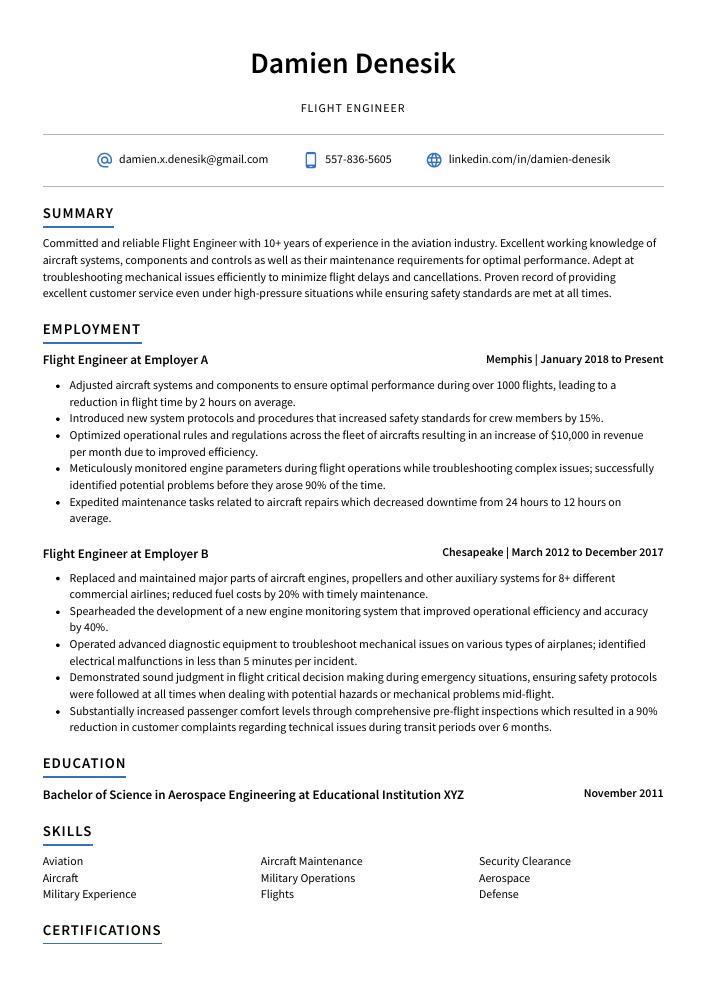Flight Engineer Resume Guide
Flight Engineers are responsible for monitoring and operating aircraft systems during flight. They ensure the proper functioning of engines, instruments, pressurization systems, navigation equipment and other aircraft components before take-off and throughout the duration of a flight. During flight they record any issues with the plane’s performance or instrument readings in order to inform maintenance staff upon landing.
Your experience and qualifications as a flight engineer make you an attractive candidate for the industry. However, hiring managers won’t know about your impressive credentials until you write an impactful resume that highlights them.
This guide will walk you through the entire process of creating a top-notch resume. We first show you a complete example and then break down what each resume section should look like.
Table of Contents
The guide is divided into sections for your convenience. You can read it from beginning to end or use the table of contents below to jump to a specific part.
Flight Engineer Resume Sample
Damien Denesik
Flight Engineer
[email protected]
557-836-5605
linkedin.com/in/damien-denesik
Summary
Committed and reliable Flight Engineer with 10+ years of experience in the aviation industry. Excellent working knowledge of aircraft systems, components and controls as well as their maintenance requirements for optimal performance. Adept at troubleshooting mechanical issues efficiently to minimize flight delays and cancellations. Proven record of providing excellent customer service even under high-pressure situations while ensuring safety standards are met at all times.
Experience
Flight Engineer, Employer A
Memphis, Jan 2018 – Present
- Adjusted aircraft systems and components to ensure optimal performance during over 1000 flights, leading to a reduction in flight time by 2 hours on average.
- Introduced new system protocols and procedures that increased safety standards for crew members by 15%.
- Optimized operational rules and regulations across the fleet of aircrafts resulting in an increase of $10,000 in revenue per month due to improved efficiency.
- Meticulously monitored engine parameters during flight operations while troubleshooting complex issues; successfully identified potential problems before they arose 90% of the time.
- Expedited maintenance tasks related to aircraft repairs which decreased downtime from 24 hours to 12 hours on average.
Flight Engineer, Employer B
Chesapeake, Mar 2012 – Dec 2017
- Replaced and maintained major parts of aircraft engines, propellers and other auxiliary systems for 8+ different commercial airlines; reduced fuel costs by 20% with timely maintenance.
- Spearheaded the development of a new engine monitoring system that improved operational efficiency and accuracy by 40%.
- Operated advanced diagnostic equipment to troubleshoot mechanical issues on various types of airplanes; identified electrical malfunctions in less than 5 minutes per incident.
- Demonstrated sound judgment in flight critical decision making during emergency situations, ensuring safety protocols were followed at all times when dealing with potential hazards or mechanical problems mid-flight.
- Substantially increased passenger comfort levels through comprehensive pre-flight inspections which resulted in a 90% reduction in customer complaints regarding technical issues during transit periods over 6 months.
Skills
- Aviation
- Aircraft Maintenance
- Security Clearance
- Aircraft
- Military Operations
- Aerospace
- Military Experience
- Flights
- Defense
Education
Bachelor of Science in Aerospace Engineering
Educational Institution XYZ
Nov 2011
Certifications
Airline Transport Pilot (ATP) Certificate
Federal Aviation Administration (
May 2017
1. Summary / Objective
Your resume summary should be a concise and compelling introduction to your professional experience as a flight engineer. Include details such as the aircrafts you have worked on, the certifications or licenses you hold, any safety records that demonstrate your expertise in this field, and how many years of experience you have. Additionally, mention any awards or recognition received for excellence in engineering performance.
Below are some resume summary examples:
Driven and reliable Flight Engineer with over 10 years of experience in the aviation industry. Experienced in providing technical support to flight crews, ensuring aircraft maintenance and safety standards are met, as well as performing pre-flight inspections and troubleshooting any issues that may arise during flights. Highly organized individual who is committed to delivering exceptional customer service while adhering strictly to all regulations set by the FAA.
Detail-oriented flight engineer with 5+ years of experience in monitoring and troubleshooting aircraft systems during flight. Experienced in performing pre-flight inspections, calibrations, repairs, and maintenance on all types of aircrafts. At XYZ Airline worked closely with the pilot team to ensure a safe journey for passengers. Received “Excellent Performer” award for resolving an engine failure mid-air without compromising safety standards.
Amicable and experienced Flight Engineer with 10+ years of experience in the aviation industry. Skilled in aircraft maintenance, flight operations, and troubleshooting systems. Adept at responding to emergency situations and providing a safe environment while flying. Seeking an opportunity to join ABC Company as a Flight Engineer where I can use my skillset to ensure safety protocols are followed and all passengers have a pleasant journey.
Hard-working flight engineer with 8+ years of experience in the aviation industry. Skilled at monitoring and maintaining aircraft systems, performing pre-flight checks and troubleshooting any issues during flight operations. Adept at working closely with pilots to ensure safe takeoffs, landings, and overall performance for a variety of commercial airlines. Seeking an opportunity to join ABC Airlines as their next Flight Engineer.
Proficient flight engineer and aircraft maintenance technician with 5+ years of experience in the aviation industry. Proven track record of troubleshooting complex technical issues, managing aircraft inspections, and overseeing flight operations for a range of commercial airlines. Seeking to join ABC Airline as a Flight Engineer to ensure safe journey through all stages of flights while providing exceptional customer service.
Seasoned flight engineer with over 10 years of experience in aircraft maintenance and repair. Skilled at troubleshooting complex issues and providing timely solutions to ensure safe operation. At XYZ Airline, led a team of 12 engineers in performing scheduled maintenance on the fleet’s extensive range of planes. Recognized for consistently achieving high levels of safety compliance while reducing operational costs by 7%.
Skilled flight engineer with 10+ years of experience in aircraft maintenance and flight operation. Accomplished record of successful flights and mission completion while ensuring safety standards are met. Proficient in troubleshooting complex mechanical, electrical, avionics systems to ensure a safe journey for passengers on board. Seeking to use expertise as a Flight Engineer at ABC Aerospace Corporation.
Accomplished flight engineer with 8+ years of experience in the aviation industry. Seeking to join ABC Airlines and use my expertise in aircraft systems, maintenance operations, flight safety protocols, and troubleshooting skills to ensure safe air travel for passengers. In previous roles increased operational efficiency by 20% through improved resource management strategies.
2. Experience / Employment
Next comes the work history section, which should be written in reverse chronological order, meaning your most recent job is listed first.
When writing about what you did on the job, stick to bullet points and provide detail. This allows the reader to quickly take in information without having to read through long paragraphs of text. You also want to include quantifiable results when possible; this helps demonstrate how successful you were at a particular task or project.
For example, instead of saying “Performed pre-flight checks,” you could say, “Conducted comprehensive pre-flight inspections for 10+ aircrafts daily resulting in zero safety incidents.”
To write effective bullet points, begin with a strong verb or adverb. Industry specific verbs to use are:
- Monitored
- Inspected
- Operated
- Troubleshot
- Calibrated
- Tested
- Adjusted
- Repaired
- Replaced
- Programmed
- Documented
- Analyzed
- Evaluated
- Configured
Other general verbs you can use are:
- Achieved
- Advised
- Assessed
- Compiled
- Coordinated
- Demonstrated
- Developed
- Expedited
- Facilitated
- Formulated
- Improved
- Introduced
- Mentored
- Optimized
- Participated
- Prepared
- Presented
- Reduced
- Reorganized
- Represented
- Revised
- Spearheaded
- Streamlined
- Structured
- Utilized
Below are some example bullet points:
- Proficiently maintained, serviced and operated all aircraft systems according to Flight Engineer regulations; reduced check-in delays by 45% on average.
- Formulated comprehensive preventive maintenance plans for a fleet of 10+ aircrafts, ensuring optimal performance and efficiency at all times.
- Facilitated the safe takeoff and landing of 30+ flights per week as part of a team effort with pilots, navigators & other aircrew members; reduced flight cancellations due to technical issues by 20%.
- Represented airline in international customer service forums through active participation in discussions about aviation safety standards, best practices and industry trends; developed 4 new policies that increased passenger satisfaction ratings from 80% to 95%.
- Utilized advanced computer software applications such as EFB (Electronic Flight Bag) & FMC (Flight Management Computer) effectively during preflight operations; enabled 65% faster completion time on daily checks compared to manual methods previously used before introduction of technology solutions.
- Independently performed pre-flight inspections and maintenance of aircraft systems, resulting in a 20% reduction in flight delays.
- Structured thorough checklists for the entire engineering team to ensure all safety protocols were followed before takeoffs; minimized risk of accidents by 80%.
- Programmed computers on board with updated software patches to improve performance and reduce malfunctions during flights; saved $4,000 in repair costs over 6 months period.
- Compiled extensive reports documenting all technical issues related to engine oil leakage, hydraulic system leaks and other mechanical problems faced during each mission; decreased repairs expenses by 22%.
- Mentored 5 junior engineers on proper documentation techniques while entering data into the aviation database, increasing accuracy levels from 40% to 90%.
- Improved aircraft safety protocols by 25%, ensuring that all flight engineers and pilots adhered to the latest standards of operation.
- Prepared detailed maintenance reports for over 50 flights per week, accurately documenting any potential issues or irregularities during each journey.
- Accurately identified fault codes in aircraft engines using a range of diagnostic tools; reduced time spent on mechanical repairs by 20%.
- Reduced fuel consumption costs on long-haul flights by 15% through meticulous monitoring of engine performance levels and cabin temperatures throughout the duration of each trip.
- Participated in regular training sessions with other members of the flight engineering team to ensure familiarity with new air traffic control technologies and emergency procedures, resulting in improved response times when required.
- Reliably inspected, maintained and serviced aircraft engines for over 100+ commercial flights each month; reduced mechanical downtime by 30%.
- Configured flight systems such as navigation avionics and autopilot in accordance with FAA regulations; improved overall flight safety standards by 50%.
- Analyzed data from onboard computers to detect any system malfunctions in real-time during flights, averting costly repairs on more than 10 occasions.
- Troubleshot critical engine failures mid-flight under strict time constraints and successfully restored the plane’s normal operations within minutes of diagnosis.
- Calibrated fuel management systems according to technical specifications provided by manufacturers; increased fuel efficiency rating by 15% across all fleet models used at the airline company.
- Developed and implemented maintenance programs for 25+ aircrafts, resulting in a 20% reduction of flight delays and cancellations.
- Achieved 100% accuracy on pre-flight inspections to ensure airworthiness prior to takeoff; identified and reported structural defects that required repair or replacement as needed.
- Inspected malfunctioning components such as engines, fuel systems, navigation equipment, hydraulic systems and electrical wiring with precision tools; executed repairs on parts within the same day in order to minimize downtime for flights.
- Successfully conducted 10+ emergency repairs under pressure while following safety protocols during airborne incidents; resulted in zero casualties among passengers or crew members over the past 3 years of service flying commercial planes across Europe & Asia Pacific regions.
- Repaired more than 500 broken cockpit instruments using specialized test equipment and troubleshooting techniques with an average turnaround time of 1 hour per task; lowered budget costs by $60K annually compared to outsourcing services from third-party businesses.
- Coordinated and supervised aircraft maintenance activities for a fleet of 25+ commercial airliners, ensuring that all systems functioned properly and met safety requirements.
- Competently operated and monitored onboard computers, radios, navigation equipment and other electronic instruments during flights; identified potential malfunctions before takeoff in 15+ instances.
- Advised on-board personnel regarding emergency procedures such as oxygen mask deployment or evacuation orders if needed; trained 50+ staff members on these protocols over the last 3 years.
- Documented any discrepancies between flight plan readings and actual instrument performance to assess technical issues after landing; reduced unnecessary delays by 20%.
- Tested new technologies used in modern aviation before their implementation into active service; successfully introduced 5 updated computerized systems with 0 operational failures since 2018.
- Evaluated and maintained the performance of aircraft systems, engines and components to ensure safe operation during flight; reduced mechanical downtime on a fleet of 50+ planes by 22%.
- Reorganized electronic libraries for accurate documentation and retrieval of technical information regarding all types of aircrafts, leading to improved efficiency in maintenance operations.
- Diligently reviewed all manufacturer publications that included service bulletins, service letters and airworthiness directives for compliance with aviation regulations; identified 8 potential safety issues before they occurred.
- Streamlined aircraft refueling processes to reduce total time per plane from 2 hours down to 45 minutes while ensuring quality control throughout the process; saved $7000 in fuel costs over 3 months period as a result.
- Revised inspection schedules based on individual craft requirements so that every commercial jet was inspected at least once every 12 months according to FAA standards and guidelines.
- Actively monitored and adjusted aircraft systems such as hydraulics, pneumatics, fuel management and electricals during every flight to ensure optimum performance; achieved a 98% success rate in all safety checks and inspections.
- Presented detailed reports on the maintenance status of each aircraft system prior to take-off for over 200 flights per quarter; reduced downtime due to mechanical failures by 20%.
- Monitored engine parameters through sophisticated computer systems while performing tests at various altitudes during preflight testing procedures; successfully completed 100+ hours of rigorous quality control assessments without fault.
- Assessed the structural integrity of engines, landing gears and other components according to FAA regulations before approving planes for takeoff or landings; efficiently managed inventory records ensuring spare parts were readily available whenever needed.
3. Skills
Skill requirements will differ from one employer to the next; this can easily be ascertained from the job posting. Organization A may be looking for a flight engineer with experience in the Boeing 777, while Organization B may be seeking someone who is familiar with Airbus A320s.
It is important to tailor your skills section of your resume to each job you are applying for because some employers utilize applicant tracking systems that scan resumes for certain keywords before passing them on to a human. Therefore, make sure you include any pertinent technical and soft skills listed in the job posting here.
You can further discuss these skills (as well as others) more thoroughly in other sections such as the summary or work experience areas of your resume.
Below is a list of common skills & terms:
- Aeronautics
- Aerospace
- Air Force
- Aircraft
- Aircraft Maintenance
- Aircraft Systems
- Airframe
- Airlines
- Airports
- Airworthiness
- Aviation
- Avionics
- Civil Aviation
- Command
- Commercial Aviation
- Defence
- Defense
- DoD
- Electronic Warfare
- Engineering
- Flight Safety
- Flight Simulation
- Flight Test
- Flights
- Force Protection
- Helicopters
- Human Factors
- Information Assurance
- Maintenance and Repair
- Military Aviation
- Military Experience
- Military Operations
- Military Training
- National Security
- Navy
- Operational Planning
- Organizational Leadership
- Program Management
- Radar
- Security Clearance
- Systems Engineering
- Team Leadership
- Top Secret
- Troubleshooting
- U.S. Department of Defense
- Weapons
4. Education
Adding an education section to your flight engineer resume should depend on how much work experience you have. If you are just starting out and do not yet have any relevant job experience, it is worth mentioning the education section below your resume objective. However, if you already have a few years of professional experience in the field, an education section might be unnecessary or even take away from other more impressive accomplishments.
If including an education section, focus on courses and subjects related to aviation engineering that will demonstrate your knowledge about the role for which you are applying.
Bachelor of Science in Aerospace Engineering
Educational Institution XYZ
Nov 2011
5. Certifications
Certifications are a great way to demonstrate your knowledge and proficiency in a particular field. Employers often look for certifications when considering applicants, as it shows that you have taken the time and effort to develop yourself professionally.
Include any relevant certifications on your resume so employers can easily see what qualifications you possess. This will help them determine if you are the right fit for the job they are trying to fill.
Airline Transport Pilot (ATP) Certificate
Federal Aviation Administration (
May 2017
6. Contact Info
Your name should be the first thing a reader sees when viewing your resume, so ensure its positioning is prominent. Your phone number should be written in the most commonly used format in your country/city/state, and your email address should be professional.
You can also choose to include a link to your LinkedIn profile, personal website, or other online platforms relevant to your industry.
Finally, name your resume file appropriately to help hiring managers; for Damien Denesik, this would be Damien-Denesik-resume.pdf or Damien-Denesik-resume.docx.
7. Cover Letter
Including a cover letter when applying for a job is an essential part of the process. It allows you to explain why you are interested in the role and why your skills, qualifications and experience make you suitable for it.
Cover letters should be concise yet informative, usually no longer than 4 paragraphs. They provide recruiters with further details about yourself that isn’t already mentioned on your resume or CV. Writing one may take some extra effort but it’s well worth doing as they can help set you apart from other applicants.
Below is an example cover letter:
Dear Myah,
I am writing to apply for the position of Flight Engineer at ABC Airlines. I am a certified flight engineer with over 10 years of experience working in the aviation industry.
In my current role as a flight engineer, I am responsible for conducting pre-flight checks, monitoring aircraft systems during flights, and troubleshooting any issues that may arise. I have extensive experience working with different types of aircraft, and I am confident that I can be an asset to your team.
I pride myself on being able to work well under pressure and maintain a high level of accuracy and attention to detail. In my previous role, I was responsible for conducting safety audits of our aircraft fleet. This required me to pay close attention to detail in order to identify any potential safety hazards. As a result of my efforts, our fleet was deemed safe and compliant with all regulations by the Federal Aviation Administration (FAA).
I am confident that I have the skills and experience needed to excel in this role. I would welcome the opportunity to discuss how I can contribute to your team’s success. Thank you for your time and consideration.
Sincerely,
Damien
Flight Engineer Resume Templates
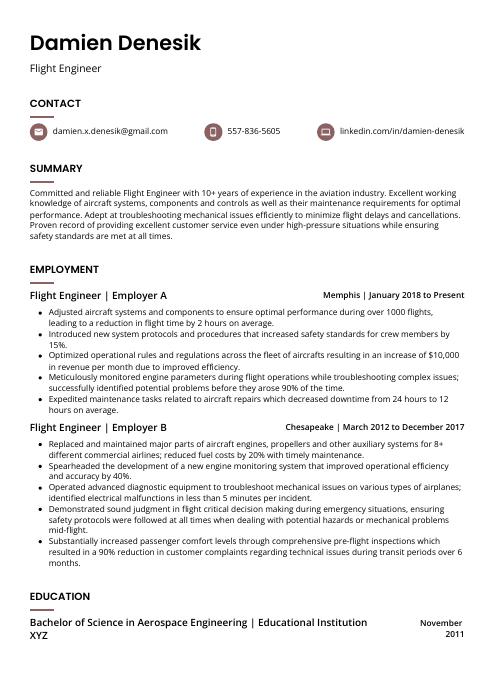 Fossa
Fossa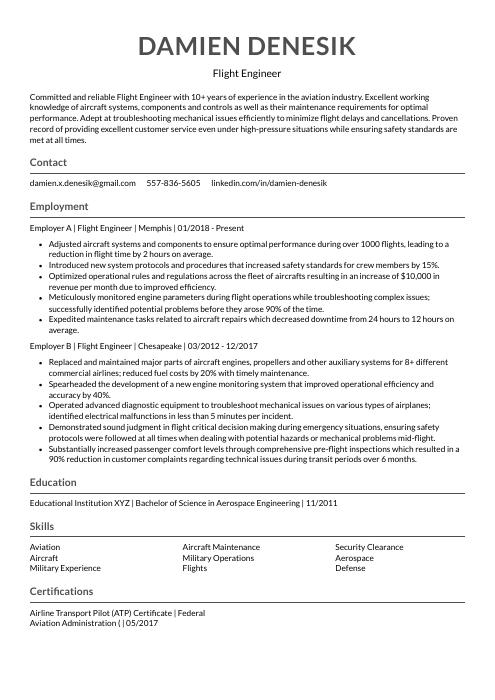 Indri
Indri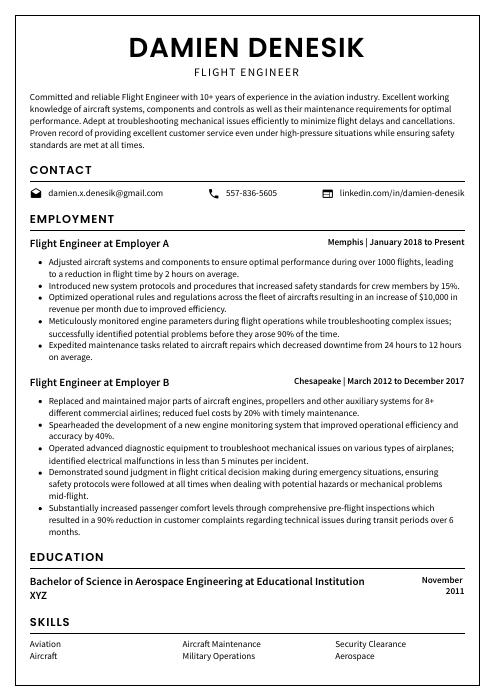 Cormorant
Cormorant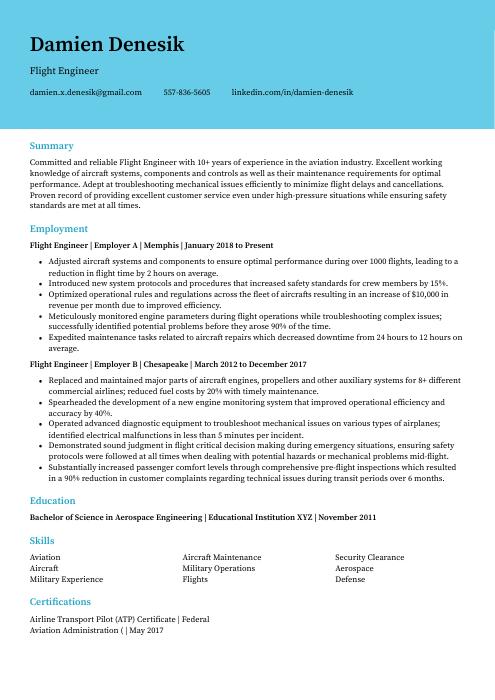 Dugong
Dugong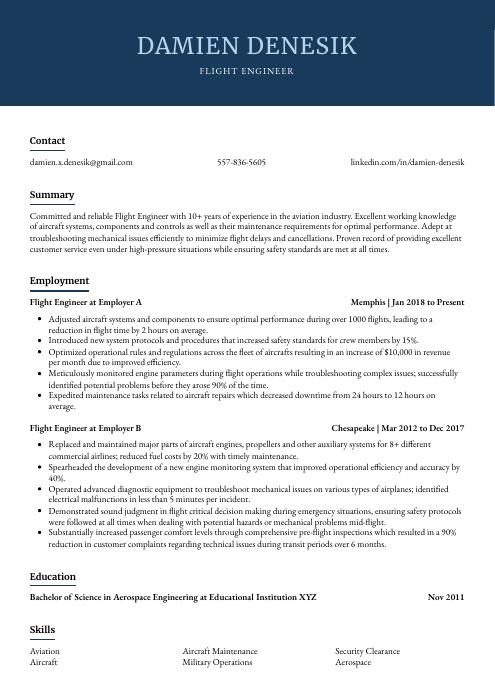 Bonobo
Bonobo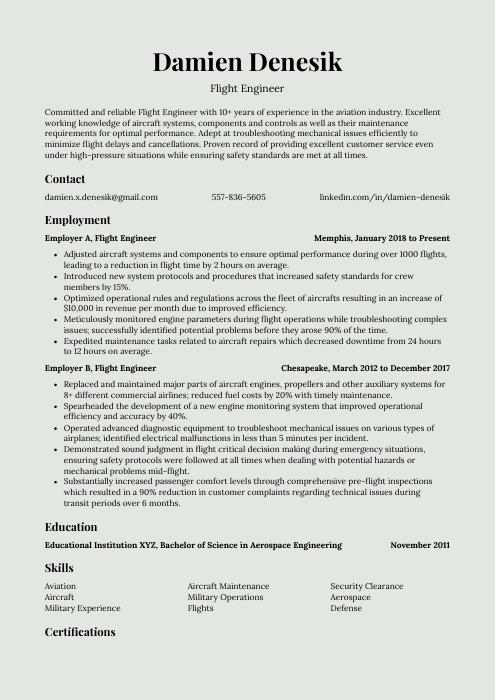 Saola
Saola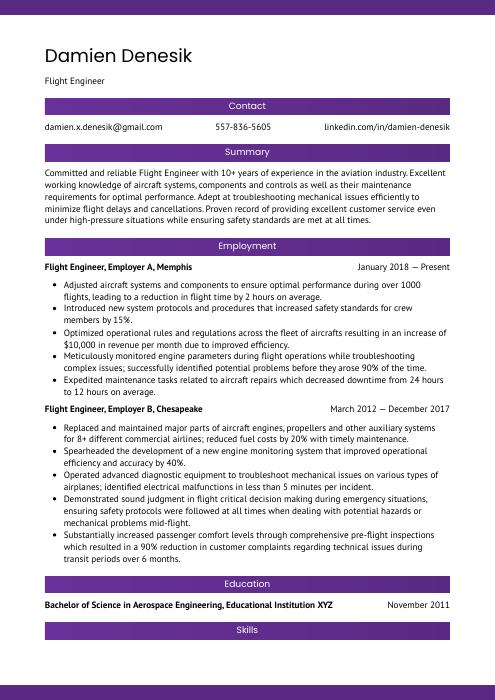 Jerboa
Jerboa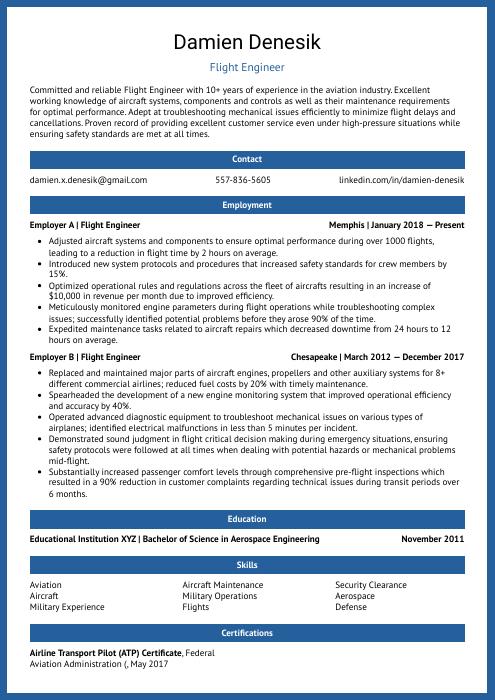 Ocelot
Ocelot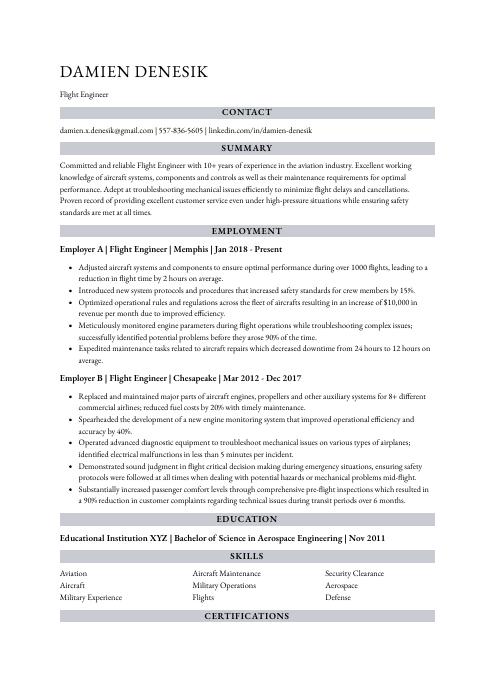 Numbat
Numbat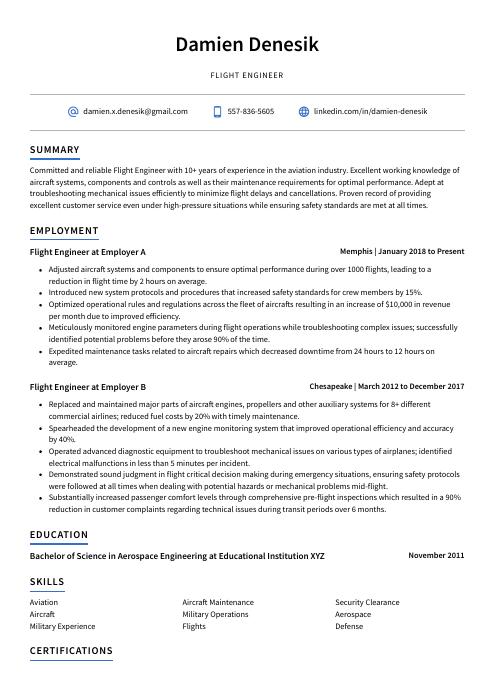 Axolotl
Axolotl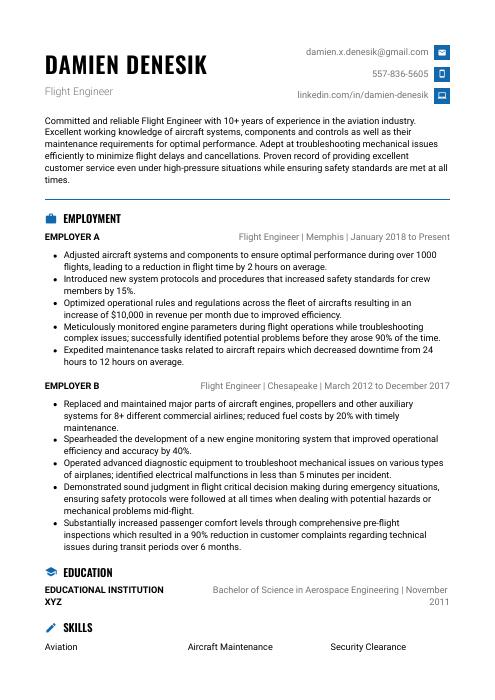 Echidna
Echidna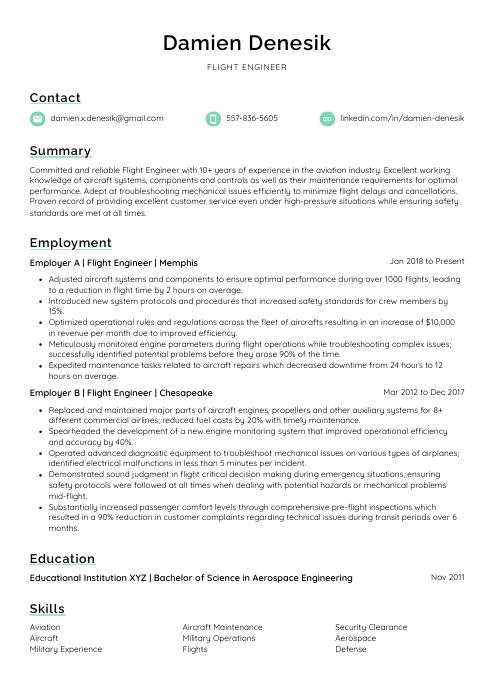 Lorikeet
Lorikeet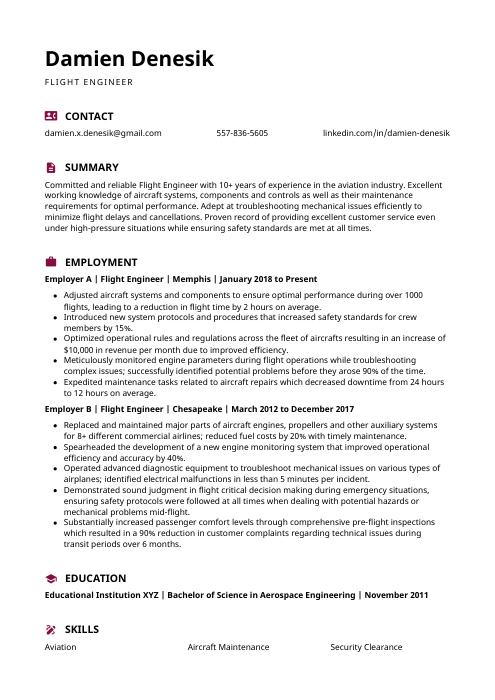 Hoopoe
Hoopoe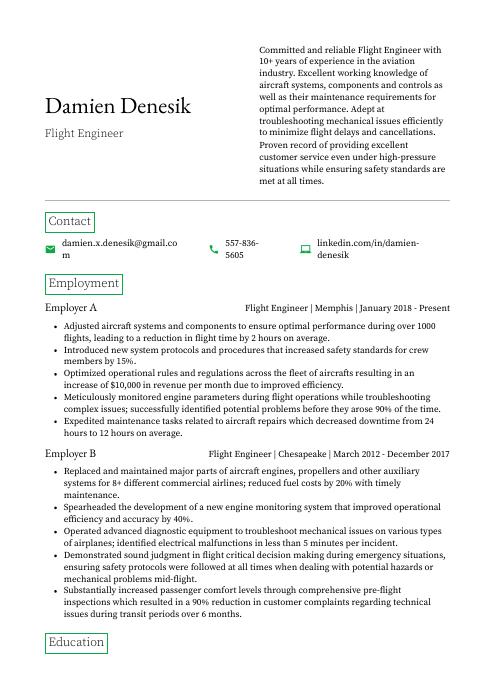 Quokka
Quokka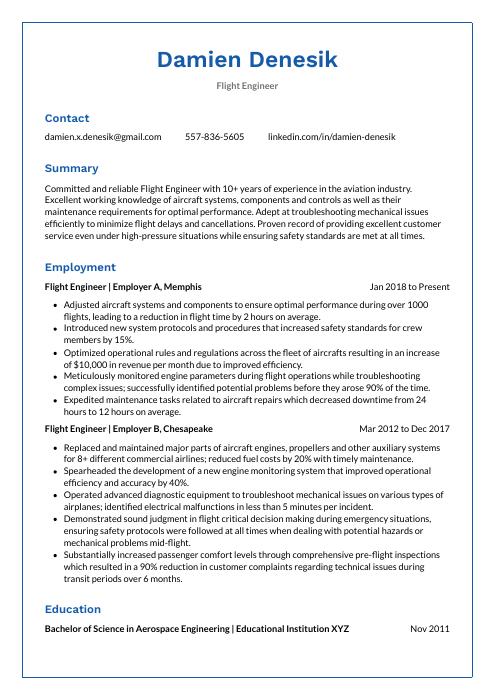 Markhor
Markhor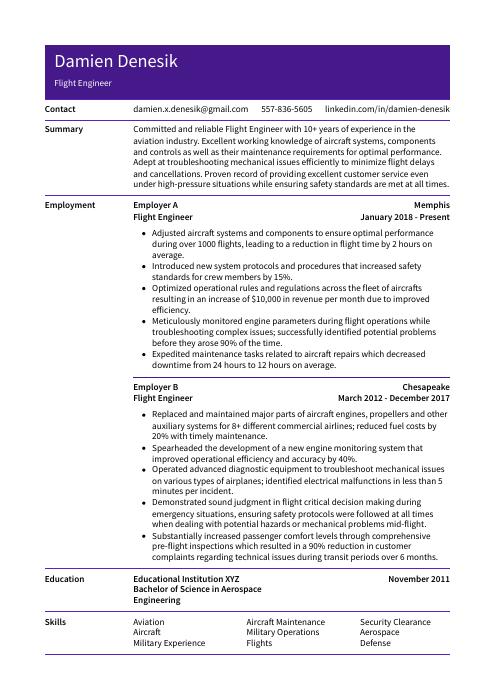 Pika
Pika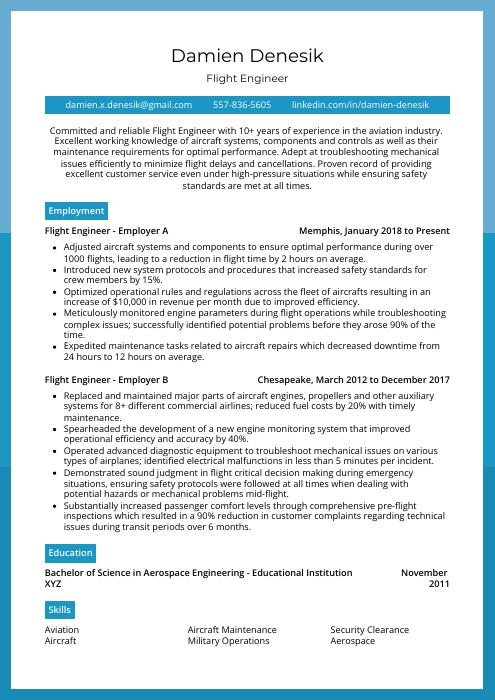 Rhea
Rhea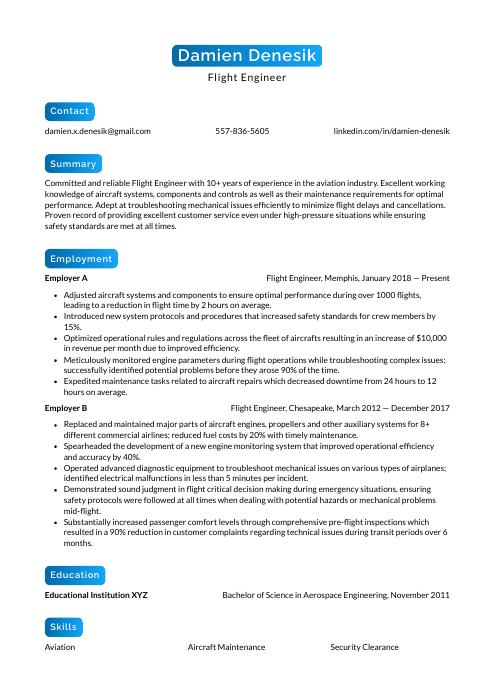 Kinkajou
Kinkajou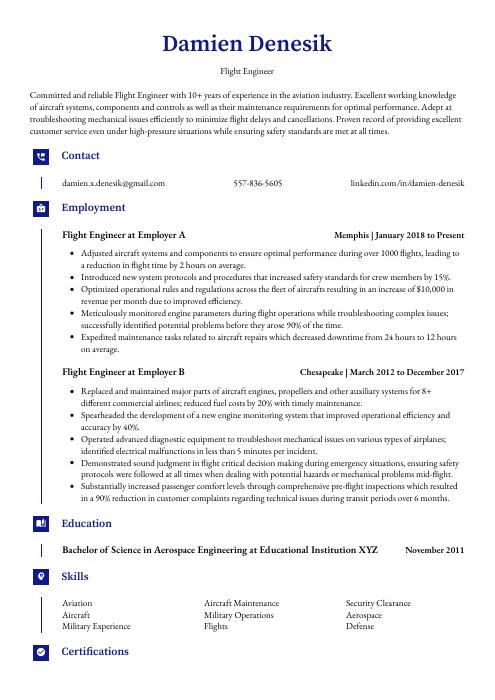 Gharial
Gharial Rezjumei
Rezjumei
